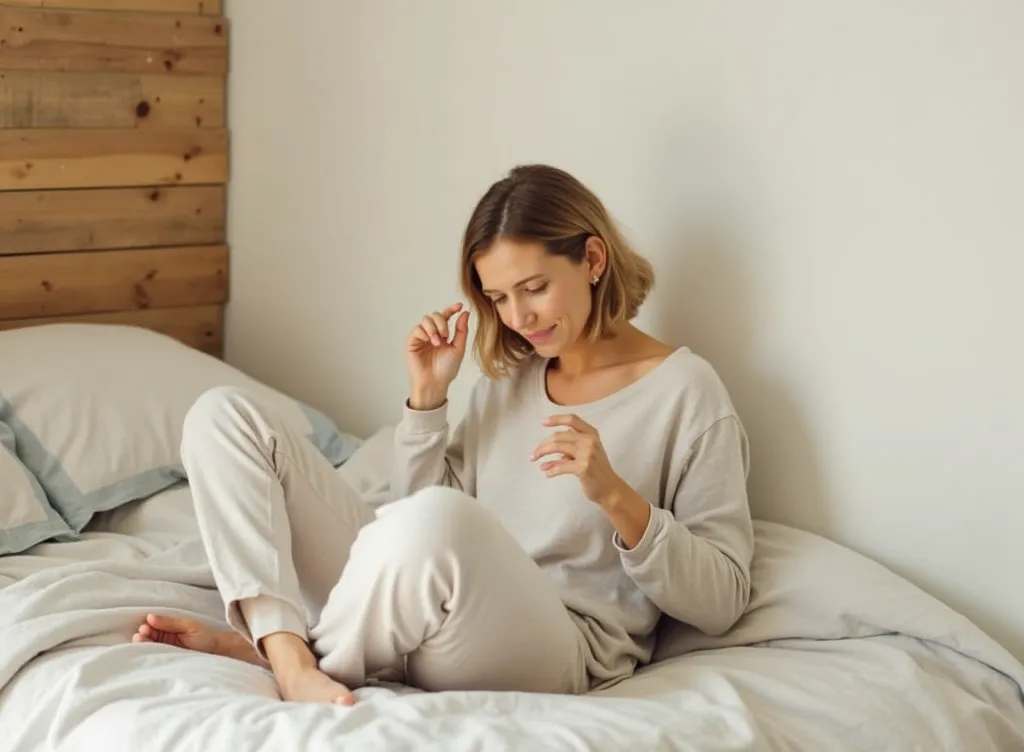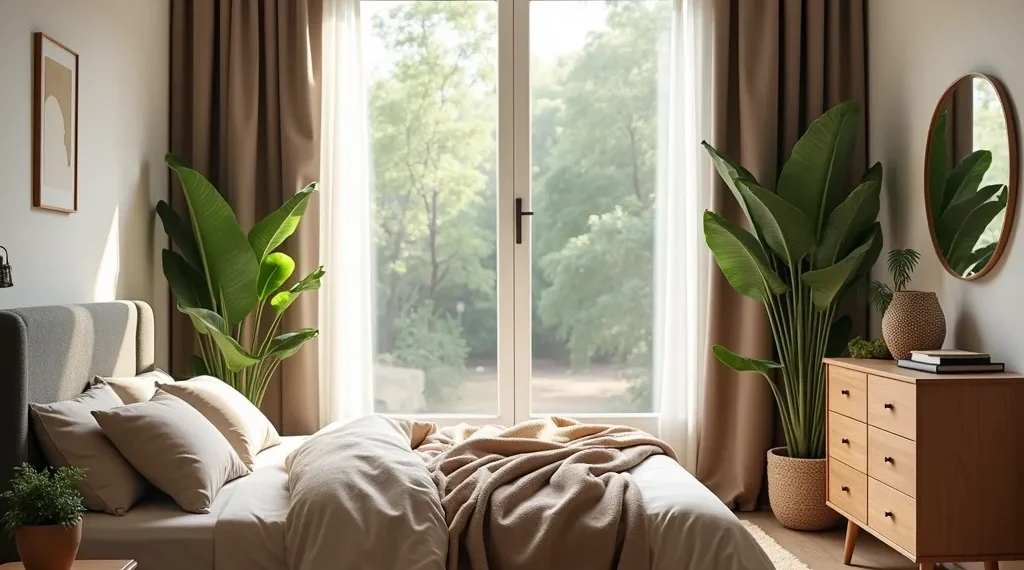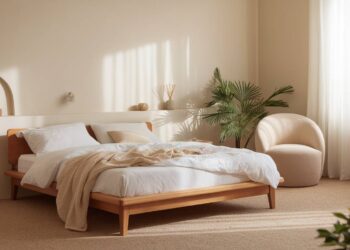Introduction
Are you lying awake at night, staring at the ceiling, wondering why peaceful sleep feels like a distant dream? In today’s fast-paced world, where stress follows us home like a persistent shadow, transforming your bedroom into a sleep sanctuary isn’t just a luxury—it’s a necessity. Studies show that 68% of Americans struggle with sleep at least once a week, but here’s the good news: by reimagining your sleeping space, you can revolutionize your rest. From the perfect temperature to the right lighting, every element of your bedroom plays a crucial role in crafting the ultimate sleep experience. Let’s explore how to turn your bedroom from a basic resting place into a tranquil haven where sweet dreams aren’t just possible—they’re guaranteed.
Making Your Bedroom a Sleep Sanctuary
If you’re desperate to catch those elusive Z’s and wake up feeling like a million bucks, revamping your bedroom into a sleep-inducing sanctuary could be the game-changer you need. The perfect sleep setup can magically melt away those late-night toss-and-turn marathons and tackle nagging insomnia like a pro.
Why Your Sleep Space Matters
Turns out, your bedroom vibes have a huge say in how well you snooze. We’ve all got a routine that begs for the right dose of chill, and that’s all about balancing light, temperature, fresh air, and bedroom bits and bobs just right. When they click, say hello to a dreamy space where sleep isn’t a battle but a breeze.
Science says your sleep digs play a starring role in your sleep drama. When sleepless nights keep crashing your sleepover party, it’s usually because your space isn’t playing nice. Transforming it into a peaceful paradise might just unknot those bedtime blues. Less reliance on those knock-you-out pills? Yes, please!
Why a Great Sleep Setup Rocks
Turning your bedroom into a snore-inducing zone pays off big time. Check out these sweet perks:
| Perk | What It Means for You |
|---|---|
| Sleep Like a Baby | Say goodbye to midnight interruptions—sleep deeper and more peacefully. |
| Mood Booster | Wake up on the right side of bed, less stressy and less anxious. |
| Turbocharged Days | Well-rested nights mean more zing to seize the day! |
| Health Hero | Sleep well, live well—better immunity and balanced hormones are on your side. |
| Train Your Sleep Rhythm | Nailing your sleep setup can get your body clock running like clockwork. |
You’re not alone on this quest for the ultimate sleepy-time setup. Dig deeper with our how to sleep better naturally guide for even more dream-boosting tricks. Time to reclaim your nights and wake up to brighter, better days!
Light Matters
Getting the right lighting is kind of like finding your slippers in the middle of the night—essential. It’s got this big role in making sure your internal clock doesn’t go all cuckoo. Known as the circadian rhythm, it keeps your sleep on track and your health in check. Juggling light exposure can really give your sleep a makeover, especially if you’re wrestling with insomnia or those random sleep woes.
“Light is the most powerful cue for shifting the phase or resetting the time of the circadian clock.” – Dr. Charles Czeisler, PhD, MD, Chief of Sleep Medicine at Brigham and Women’s Hospital
Importance of Darkness for Quality Sleep
When it gets dark, that’s the body’s cue to start shutting down for the evening. Darkness turns on the melatonin factory in your brain, pumping out the good stuff that helps regulate when you’re awake and when you’re in snooze mode. If you skimp on the dark, you’re basically asking for a sleep drama. You might find it tough to drift off, or stay there.
Let’s tackle how to keep it so dark you might just bump into your bed:
| How to Keep Things Dark | What’s the Scoop? |
|---|---|
| Blackout Curtains | Kiss goodbye to outside light—keep things pitch black. |
| Sleep Masks | Block out the world! These are golden, especially if you’re off gallivanting. |
| Dim Lighting | Get a cozy glow going in the evening to nudge your body to chill. |
| Skip the Screens | Drop the tech before bed—cut the blue light antics. |
Using Natural Light to Regulate Sleep Cycles
So, natural light struts in and kicks that circadian rhythm into action, saying, “Hey, it’s awake time!” Catching some rays in the morning can give you a jolt of energy, so you’re not dragging your feet and can stick to a solid sleep routine. It’s kind of a hero move for night shift champs or anyone with a wonky sleep timetable.

Here’s how you can let the sunshine in:
| Getting the Sun’s Rays to Work for You | What’s the Plan? |
|---|---|
| Morning Sunlight | Chill outside in the morning—let the sun’s rays do their magic. |
| See-Through Curtains | Go for curtains that let sunshine stream in without turning your home into a greenhouse. |
| Outdoor Breaks | Sneak outside for a few, soak up that sweet natural light daily. |
| Toss the Heavy Curtains | Cut back on blocking out the sun during daytime. |
Balancing darkness at bedtime and basking in light during the day can level up your sleep game. For more savvy tips on building the snooze haven of your dreams, check out how to sleep better naturally.
Temperature and Air Quality
Getting a good night’s rest often comes down to the basics: keeping your sleep space just right. Temperature and air quality are key players in setting up a cozy nest for drifting off to dreamland. If you’re aiming to turn your bedroom into a snooze-friendly zone, these factors need your attention.
“The thermal environment is one of the most important factors that can affect human sleep.” – Dr. Christopher Winter, Medical Director at Charlottesville Neurology & Sleep Medicine
Finding the Ideal Sleep Temperature
What’s the best temperature to sleep in? Well, it depends. Everybody’s a little different, but most folks find cooler is better. Experts say between 60°F and 67°F (a cozy 15°C to 19°C) works like a charm for catching those Zs.
| Temperature | Your Sleep Experience |
|---|---|
| 60°F – 67°F | Just right for snoozing |
| Below 60°F | Might feel like the Arctic and disrupt your shut-eye |
| Above 67°F | Could have you sweating the night away |
Remember, it’s not just about the thermostat. Get comfy with layers of bedding or clothing. This way, you can tweak your warmth with ease.
Improving Air Quality for a Restful Environment
Breathing easy while sleeping can boost how well you sleep. Here’s some simple ways to crank up that air quality:
Ventilation: Fresh air keeps the nasties like allergens and stale air at bay. Crack open a window when you can. If that doesn’t cut it, consider getting an air purifier to do the job.
Humidity Control: Keep that moisture in the sweet spot, roughly 40-60%. If the air’s desert-dry, a humidifier will help. Feel like you’re in a swamp? A dehumidifier can dry things out.
Natural Elements: Add a couple of houseplants to the mix. Some green pals can naturally clean up the air for you. Plus, they look nice!
| What to Focus On | Ideal Setting | How to Fix It |
|---|---|---|
| Air Quality | Fresh and circulating | Go with air purifiers or open those windows |
| Humidity | 40% – 60% | Bring in the humidifiers or dehumidifiers |
Got the hang of it yet? If you’re curious about more ways to spruce up your sleep zone, check out some tricks like aromatherapy sleep benefits or diving into essential oils for sleep. Nail the balance between temperature and air quality, and you’ll be set for some solid slumber, feeling all refreshed in the morning.
Embrace Nature’s Sleep Magic
Turning your bedroom into a nature-inspired oasis can work wonders for catching those Z’s and snoozing like a champ. Bring a bit of the wild indoors and find yourself drifting off like never before.
Go Green (and Wooden) in Your Bedroom
Jazzing up your room with natural touches can do more than just look pretty—it can make the vibes chill and your sleep a dream. Think about adding goodies like soft organic cotton sheets, sturdy wooden furniture, or letting buttery sunlight stream in whenever possible.
When setting up your nap haven, keep these in mind:
| Thing to Add | What It Does for You |
|---|---|
| Cozy Natural Fabrics | Keeps the nasties away; lets your skin breathe |
| Wooden Stuff | Makes the space feel snug and inviting |
| Earthy Colors | Think greens and browns for ultimate relaxation |
| Sunlight Sources | Helps control sleep chemicals in your brain |
Using stuff inspired by nature has this way of dialing down the stress and getting your mind right for bedtime.
Let Plants Do the Work While You Snore
Plants aren’t just green buddies—they’re the MVPs of a stellar sleep environment. They can clean the air, adjust the humidity, and just make the entire room feel like a gentle hug, all while sweetening your dreams.
Check out these leafy pals:
| Plant Buddy | What It Brings to Bedtime |
|---|---|
| Soothing Lavender | Smells divine and helps you relax |
| Easy Snake Plant | Boosts oxygen flow; gives the air a boost |
| Toxin-Zapping Peace Lily | Clears out the bad stuff floating around |
| Simple Aloe Vera | Keeps air fresh; super low-maintenance |
| Dreamy Jasmine | Fills the air with a calming scent |
These plants are not just eye-candy; they cozy up the place and make it a sleep sanctuary. And if you’re looking to double down on bedtime relaxation, peek at essential oils for sleep—they work wonders alongside your new plant pals.
By setting up a nature-rich sleep space that speaks zen and green, you’re setting the stage for some top-tier slumber. For more tips on stepping up your sleep game, pop over to our reads on how to sleep better naturally and breathing exercises for sleep. Sweet dreams!
Noise Reduction
Getting a good night’s sleep is like winning the lottery. Well, almost. The point is, peace and quiet equal snooze heaven, while noise? That’s a recipe for tossing and turning all night. Let’s check out how sounds mess with our Z’s and what you can do to keep the decibels down.
Impact of Noise on Sleep Quality
Noise is like an uninvited guest at a cozy fireside chat—it gets in the way of everything. We’re talking messed-up sleep, the kind where your heart races faster than a sprinter and your stress is cranked up like a Metallica concert. And that’s not all; even whispers in the night can mess with deep sleep, the kind that makes you feel human again.
| Noise Type | Impact on Sleep Quality |
|---|---|
| The Hum of City Life | May disrupt your REM cycle quicker than you can say “hit the snooze” |
| Sudden Loud Bangs | Could yank you from the depths of sleep |
| Gentle Night-Time Whispers | Might up your heart rate and blood pressure when you’re trying to catch those Z’s |
Strategies to Minimize Disruptive Noises
Don’t let noise be the boss of your sleep. Here’s how to turn the volume down on the nocturnal sound show:
- Soundproofing: Think of heavy curtains, plush carpets, or even fancy soundproof panels as your trusty sleep bouncers, keeping unwanted sounds outside.
- White Noise Gadgets: These nifty gadgets produce a consistent sound that shushes the city’s hustle and bustle. Urban warriors, take note.
- Earplugs: Little magic stoppers that can make the loudest snorer sound like a distant daydream.
- Green Wall of Silence: Okay, not to be dramatic, but a few ferns or rubber plants can slurp up noises. Plus, they look nice.
- Quiet Time Rules: A household rule that keeps noise on the DL when you’re trying to head to dreamland.
- Soothing Sound Apps: There’re apps for everything, including ones that trick your brain into thinking you’re sleeping by the ocean. Handy, right?
Shaving off the sonic stress in your sleeping area could mean a date with quality sleep. If you’re nodding along and already wide-eyed waiting for more tips, give a peek to our guides on how to sleep better naturally and aromatherapy sleep benefits.

Comfort is Key
You ever tried sleeping on a rocky pile of bricks? Neither have I, but I can imagine. A comfy bedding setup is like drifting on a cloud, and it can make or break your night’s rest. Get the right sheets, pillows, and mattresses, and you’ll be dreaming of that perfect spot under a tree in no time.
Importance of Comfortable Bedding
Bedding isn’t just about snuggling up; it’s about cradling your back, neck, and dreams. When your sheets feel like a hug and the pillow fits just right, sleep comes faster and interruptions become a midnight myth. It’s not just about what you want; it’s about what your body needs.
Here’s what makes comfy bedding:
| Bedding Component | What to Look For |
|---|---|
| Mattress | Fits how you sleep, material that hugs, fits your space |
| Pillows | Not too big, not too flat, just right for your head and neck |
| Sheets | Soft, cozy, strong enough to last |
The magic happens when you find the bedding that your dreams are made of. Curious for more sleep tips? Check out our piece on getting natural sleep tips.
Choosing Natural and Sustainable Materials
Sleep like you’re saving the planet, too. Natural and sustainable bedding materials score points for good rest and a green conscience. Think organic cotton, bamboo, or linen—all breathable champs that need a spot in your sleep haven.
Going green? You’re also doing the earth a solid by choosing options that are gentle on you and Mother Nature. Here’s a quick glance at some go-to materials:
| Material | Perks | Things to Note |
|---|---|---|
| Organic Cotton | Feels soft, keeps you cool, gentle on skin | Might cost a bit more |
| Bamboo | Keeps sweat away, fights bacteria | Not all bamboo is born equal |
| Linen | Lasts long, stays fresh, keeps you cozy | Can be a bit crinkly, texture’s not for everyone |
Stick to natural; avoid dodgy chemicals sneaking into your bed. For more natural sleep helpers, peek at our guides on herbal sleep tricks or read up on scent-sational sleep enhancers. Choosing cozy bedding is like tucking into the perfect spot every night.
Technology-Free Zone
Ditching technology gadgets in the bedroom is a big win for good sleep vibes. Zoning out into slumber land gets easier without the screen drama right before bed.
The Adverse Effects of Technology on Sleep
Loads of studies wink at how tech messes with sleep. Those bright screens fill the room with blue light, messing with melatonin—your sleep buddy. Suddenly, nodding off becomes a mission impossible. Here’s a quick peek at how tech messes with your snooze:
| Effect | Description |
|---|---|
| Delayed Sleep Onset | Struggling to sleep thanks to screen buzz. |
| Reduced Sleep Quality | Sleep cycles thrown off by glaring screens. |
| Shortened Sleep Duration | Burning the midnight oil with gadgets cuts snooze time. |
| Increased Anxiety | Scrolling social media ups pre-sleep jitters. |
Cutting back on screens before bed’s a no-brainer if you wanna kiss insomnia goodbye and feel more alive in the morning.
Establishing Technology-Free Areas in Your Bedroom
Making your bedroom a chill zone involves booting out the gadgets. Here’s some friendly advice to craft that peaceful retreat:
Ditch the Devices: Let your phones and gadgets chill elsewhere, not in your sleep space.Set Up a Chill Corner: Pick a spot for calm stuff like reading or meditation—zero screens allowed. Need some zen ideas? Check out our sleep meditation techniques.
Go Old School: Swap that digital clock for a classic one to dodge the device-checking itch.Lay Down the Law: Decide on a no-gadgets rule, especially as bedtime looms. This habit smooths the way to sleep bliss.
Going tech-free amps up your sleep quality and overall vibe. Simple changes dial down the noise and welcome peaceful nights. Dive into more tips with our guides on how to sleep better naturally, aromatherapy sleep benefits, or breathing exercises for sleep. You’ve got this!
Routines and Rituals
Kicking back and falling into a restful snooze doesn’t have to be a wild dream. It’s about weaving comforting rituals into your nighttime routine, easing that mind and body into sleep mode. These practices work wonders for folks tossing and turning with insomnia, parents chasing kiddie Zs, or shift workers battling crazy hours.
Setting Up Relaxing Pre-Sleep Rituals
Flagging down a good night’s sleep starts with setting up a chill routine that whispers, “Hey, it’s bedtime.” These end-of-day activities are a personal thing. They might involve a book, some tunes, or gentle moves like yoga to help you relax:
| Ritual | Time to Get Cozy |
|---|---|
| Flipping through a book | 20-30 minutes |
| Stretching or a bit of yoga | 15-20 minutes |
| Jamming out to calming music | 15-30 minutes |
| Brewing up some herbal tea | 10 minutes |
| Zoning out with meditation | 10-15 minutes |
Boost your bedtime bliss with a whiff of essential oils—lavender and chamomile are sleep superstars. Whether you want to dab it on or let it waft through the room, check out aromatherapy sleep benefits and get the skinny on essential oils for sleep.
Establishing Consistent Sleep Patterns
Nailing down a solid sleep schedule is your ticket to dreamland. Keeping regular sleep and wake times helps your body’s clock tick smoothly, tuning you up for better sleep quality. For those wrestling with inconsistent snooze cycles, this is key.
| Weekday Routine | Weekend Routine |
|---|---|
| Stick to the same sleep times | Sleep and wake close to your weekday routine |
| Keep naps under 30 minutes | If you must nap, make it brief |
Handling stress with breathing exercises for sleep can make drifting to sleep as easy as counting sheep. Techniques like deep breathing mellow out anxious vibes and calm the mind before hitting the hay.
Part of winding down might also include sleep meditation techniques, with a side of light yoga. And if you’re rooting around for other natural ways to ease into sleep, peek at herbs for better sleep and foods that help you sleep. Stitching these approaches together creates a cozy nook of serenity where restful sleep can settle right in.
Conclusion
Creating your perfect sleep sanctuary isn’t just about following a checklist—it’s about crafting a personalized haven that honors your body’s natural sleep rhythms. By mindfully implementing these elements—from optimizing temperature and lighting to embracing nature and banishing technology—you’re not just designing a bedroom; you’re investing in your health, happiness, and overall quality of life. Remember, quality sleep is the foundation of a vibrant life, and your bedroom is the architect of that foundation. Start with one change today, whether it’s adding blackout curtains or introducing a calming plant, and watch as your sleep sanctuary evolves into the restful retreat you’ve always dreamed of. Sweet dreams await in your newly transformed space.
FAQs
Q: What is the ideal bedroom temperature for sleeping?
A: The optimal sleeping temperature ranges between 60-67°F (15-19°C). This range helps maintain your body’s natural temperature drop during sleep.
Q: How dark should my bedroom be for optimal sleep?
A: Your bedroom should be as dark as possible, with less than 5 lux of light (equivalent to moonlight). Use blackout curtains or an eye mask if needed.
Q: Can plants really improve sleep quality?
A: Yes, certain plants like lavender, snake plant, and jasmine can improve air quality and promote relaxation through natural aromatherapy.
Q: How long before bed should I stop using electronic devices?
A: Experts recommend stopping use of electronic devices at least 1-2 hours before bedtime to allow your body’s melatonin production to normalize.
Q: What type of mattress is best for a sleep sanctuary?
A: The best mattress depends on individual needs, but generally, medium-firm mattresses (5-7 on the firmness scale) provide optimal support for most sleepers.
Q: How often should I update my bedding for optimal sleep?
A: Replace pillows every 1-2 years, mattresses every 7-10 years, and wash bedding weekly to maintain a clean, comfortable sleep environment.
Resources
National Sleep Foundation: Sleep Environment Guidelines
Harvard Medical School: Healthy Sleep
Mayo Clinic: Sleep Tips
American Academy of Sleep Medicine: Bedroom Environment
Sleep Research Society: Latest Sleep Studies








